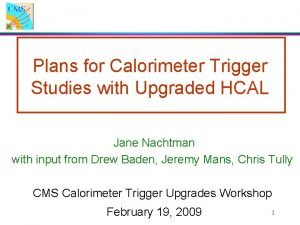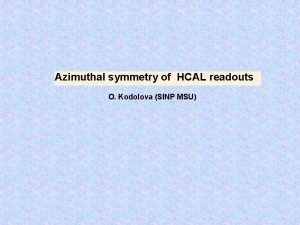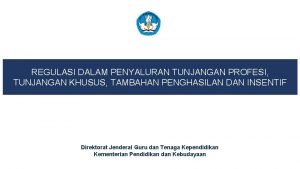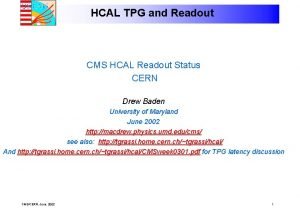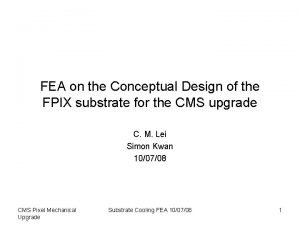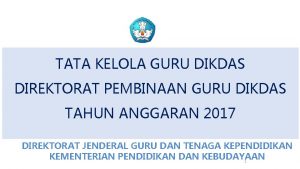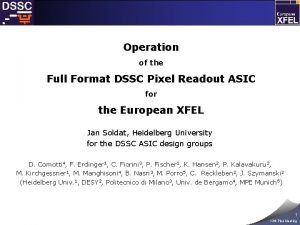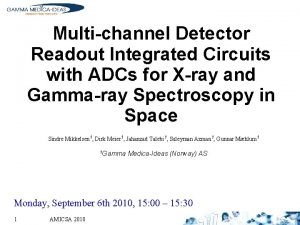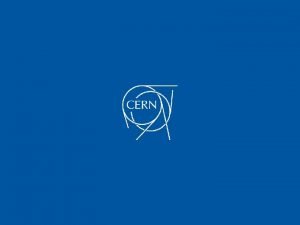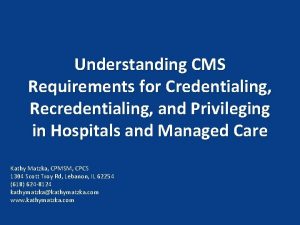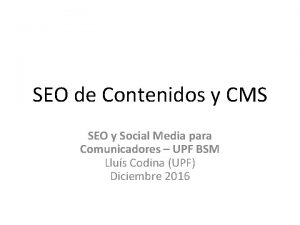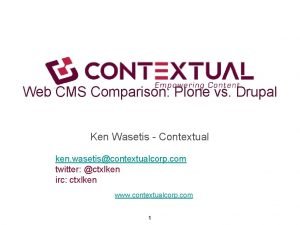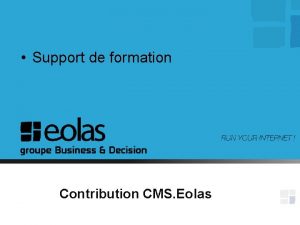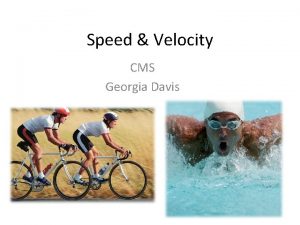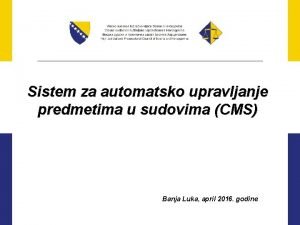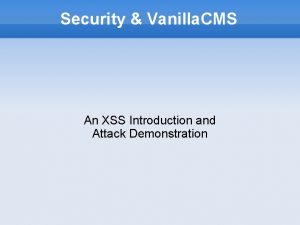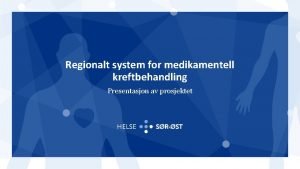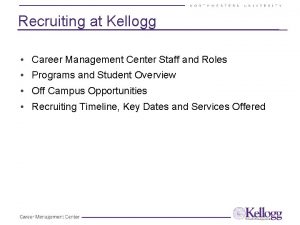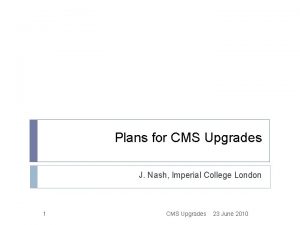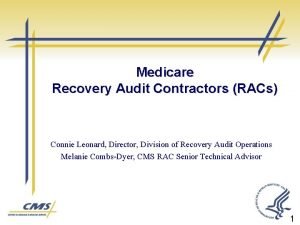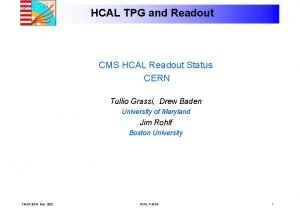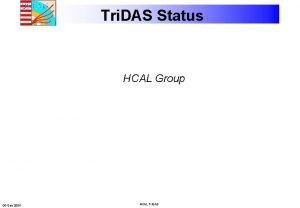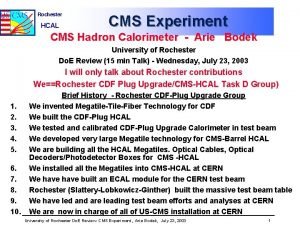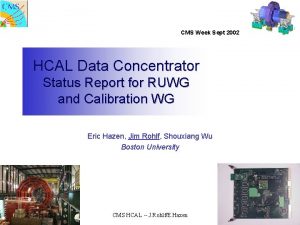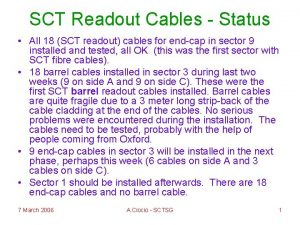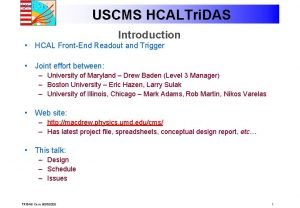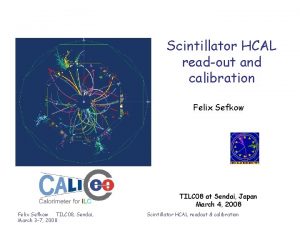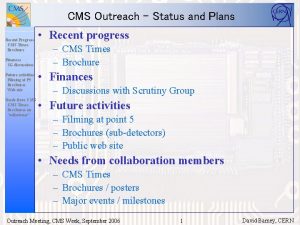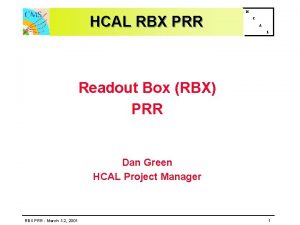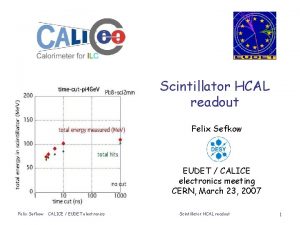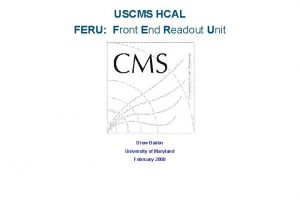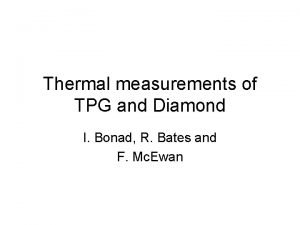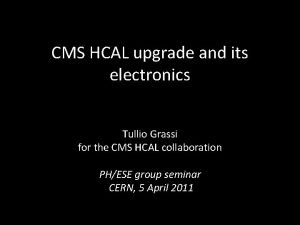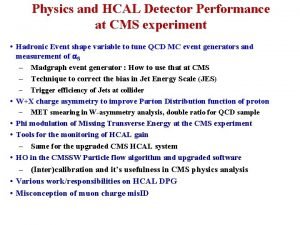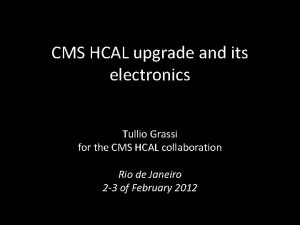HCAL TPG and Readout CMS HCAL Readout Status























- Slides: 23

HCAL TPG and Readout CMS HCAL Readout Status CERN Drew Baden University of Maryland March 2002 http: //macdrew. physics. umd. edu/cms/ see also: http: //tgrassi. home. cern. ch/~tgrassi/hcal/ CMS/CERN. Mar, 2002 HCAL Tri. DAS 1

Readout Crate Changes • Outside world – slow monitoring, controls…. – Bit 3 PCI/VME interface Front End Electronics TTC fiber • Known quantity Gbit Ethernet @ 1. 6 Gb/s – 3 U Rack Computer • Dual processor DELL, fast PCI bus – Chris Tully to take responsibility – I’m keeping track of M&S for operations • Not yet added to WBS (I think…. ) • UIC/HRC replaced by TTC/Clock Fanout – “HRC” did some of the above – Clock fanout is critical for VME crate functions – Fanout to all HTRs F B a D H H I n C T T T O C 3 u (s) R R t • Fewer HTR/crate – Mapping considerations – Dual-width DCC considerations DAQ . . . H H T T R R 20 m Copper Links 1 Gb/s • Not yet settled. I don’t like it…but we’ll see… Calorimeter Regional Trigger CMS/CERN. Mar, 2002 HCAL Tri. DAS 2

HCAL TRIGGER and READOUT Card • No functional changes since Dec-2001 • I/O on front panel: – Inputs: Raw data: • 16 digital serial fibers from QIE, 3 HCAL channels per fiber = 48 HCAL channels – Inputs: Timing (clock, orbit marker, etc. ) • PECL – Outputs: DAQ data output to DCC • Two connector running LVDS • TPG (Trigger Primitive Generator, HCAL Tower info to L 1) via P 2/P 3 – Use aux card to hold Tx daughterboards – Via shielded twisted pair/Vitesse • FPGA logic implements: – Level 1 Path: • Trigger primitive preparation • Transmission to Level 1 – Level 2/DAQ Path: • Buffering for Level 1 Decision • No filtering or crossing determination necessary • Transmission to DCC for Level 2/DAQ readout CMS/CERN. Mar, 2002 HCAL Tri. DAS 3

Demonstrator Status • Demonstrator – 6 U HTR, Front-end emulator • Data, LHC structure, CLOCK • 800 Mbps HP G-Links works like a champ • Dual LCs – This system is working. FEE sends clock to HTR, bypasses TTC 6 U HTR Demonstrator • HCAL FNAL source calibration studies in progress • Backup boards for ’ 02 testbeam – Decision taken 3/02 on this (more…) – Anticipate we will abandon this card for testbeam – DCC full 9 U implementation • FEE HTR DCC S-Link CPU working – Will NOT demonstrate HTR firmware functionality as planned • Move to 1. 6 Gbps costs engineering time • Firmware under development now CMS/CERN. Mar, 2002 HCAL Tri. DAS 6 U FEE 4

HTR “Dense” Scheme De. S 8 FE fibers 24 QIE-ch’s OPTICAL Rx (8 LC) De. S Throughput: 17 Gb/s Latency: + 2 TCK P 1 SLB -PMC FPGA Xilinx Vertex-2 SLB -PMC De. S LVDS Tx De. S P 2 Trigger output 48 Trigger Towers to DCC SLB -PMC De. S 8 FE fibers 24 QIE-ch’s OPTICAL Rx (8 LC) De. S FPGA Xilinx Vertex-2 P 3 De. S to DCC CMS/CERN. Mar, 2002 LVDS Tx SLB -PMC De. S 9 U Board HCAL Tri. DAS SLB -PMC 5

“Dense” HTR • Dense (48 channel) scheme is now the baseline – Money • Fewer boards! – Programmable logic vs. hardware • Avoid hardware MUXs • Maintain synchronicity – Single FPGA per 8 channels • Both L 1/TPG and L 1 A/DCC processing – Next generation FPGAs will have deserializers built in • • • Xilinx Vertex-2 PRO and Altera Stratix announced Saves $500/board $100 k ~20 connections to deserializer reduced to 1 connection at 1. 6 GHz Single clock would serve 8 deserializers Probably won’t get to have any of these chips until summer 02…. schedule may not permit – We will keep our eye on this – 48 channels x 18 HTR x LVDS Tx to DCC exceeds DCC input bandwidth • So, need 2 DCC/crate (but fewer crates) CMS/CERN. Mar, 2002 HCAL Tri. DAS 6

Prototype Status FPGA+8 deserializers • TPG transmission changed VME FPGA – From SLB mezzanine cards to Backplane aux card • Solves mechanical problems concerning the large cables to Wesley • 1. 6 GHz link Out to DCC – Wider traces, improved ground planes, power filtering, etc. – Deserializer Ref. Clock fanout – TTC daughterboard changed to TTC ASIC – Fixed TI deserializer footprint problem – Clocking fixes TTC and Clock distribution • Next iteration estimate – Submit in 2 weeks – Stuffed and returned – by April 1 OLD DESIGN CMS/CERN. Mar, 2002 HCAL Tri. DAS Dual LC Fiber Connector 7

Current Hardware Status HTR Dual LC (Stratos) Receivers 2 de. Serializers • 1. 6 GHz link is the hardest part – Made a “Link. Only” board – 2 dual LCs feeding 4 TI deserializers • • TI TLK 2501 TRANSCEIVER 8 B/10 B decoding 2. 5 Volts 80 MHz frame clock – 20 bits/frame – Internal use only – This board works. • We “know” how to do the link now – Did not test the tracker NGK option NGK “Tracker” CMS/CERN. Mar, 2002 Dual LC (Stratos) Transceiver HCAL Tri. DAS 8

HTR Issues • Optical link – Stratus LC’s work well, available, not very expensive, probably will get cheaper. – “Tracker solution”? We think no…this option appears to be dead. • NGK/Optobahn not responsive • Time scales for HTR is this summer – Tracker group has kept us at arms length with respect to vendors – Anticipate much ado about getting quotes and signing orders – schedule risk is too great • Savings is approximately $50/channel ($150 k overall) – Expect LC’s to get cheaper…will the NGK? • Clocking – Jitter requirements are surprising – refclk needs to be 80 MHz ± ~30 k. Hz to lock and stay locked. • This is because we are using a Transceiver, not a Receiver – TI does not have a Receiver – this is Gigabit ethernet, so it’s meant for 2 -way • We can implement in 2 ways – Onboard crystal – PECL clock fanout • Will have both for next iteration, board that will be in the testbeam summer ’ 02 CMS/CERN. Mar, 2002 HCAL Tri. DAS 9

HTR Clocking • TTC provides input clock for the VME crate modules. • Clocks needed: – DCC not critical – HTR: • • Deserializers (16) need 80 MHz clock with ~40 ps pkpk jitter TPG transmission needs 40 MHz clock with ~100 ps pkpk jitter Pipeline needs 40 MHz clock synchronous with data transmission Options – eliminate: – 80 MHz crystal (eliminates 1 Mux) – TTC Fanout Board clock to deserializers (eliminates 1 2 Fanout and 1 Mux) – We will see what we learn at the Testbeam ‘ 02 HTR Board TTC Fanout Board TTCrx TTC MUX TTC PECL Fanouts to HTRs Clock/BC 0 80 MHz LVPECL Crystal 1 to 8 Fanout 1 2 Fanout 80 MHz d e s e r i a li z e r s SLB Board 40 MHz Clock/2 CMS/CERN. Mar, 2002 HCAL Tri. DAS 10

HTR Schedule Production Phase Prototype 4/1/02 Checkout 2 -3 FTE months April 02 In parallel May 02 OK? Testbeam Run May/June 02 Prepare Prod’n Prototype 1 FTE month April 02 Checkout Prod’n Prototype 1 FTE month Jun-Aug 02 Production Prototype May 02 Next iteration requires less checkout time…. • Testbeam Phase – Next Checkout: 3 months – Fix problems: 0. 5 months – Next checkout if needed: 1 month • Fix 2 FTE weeks Cards at CERN July 1 at latest Production Run Fall 02 Production Checkout 3 -6 FTE month FPGA coding ongoing Production Phase – Prep for next pre-production run: 1 month – Checkout for production prototype: 1 month – Production checkout: 3 -6 months • • • FPGA coding: 6 months ? Total: 1. 5 FTE years, around $180 k Integration: ongoing…difficult to say Testbeam Phase CMS/CERN. Mar, 2002 HCAL Tri. DAS 11

Current Project Timeline 2000 2001 2002 2003 2004 Demonstrator Project 1. 6 GHz Link Pre-Production Installation FNAL source calib. Done Begins between March and Sept 2003 Slice Test I Test Beam Jun-Sep STILL SOME UNCERTAINTIES… CMS/CERN. Mar, 2002 • Vertex-2 PRO or Altera Stratix • Global clocking scheme • Clock jitter HCAL Tri. DAS 12

DATA CONCENTRATOR CARD Motherboard/daughterboard design: – VME motherboard to accommodate PCI Interfaces 3 LVDS inputs per card 6 cards per DCC (= 18 inputs) Engineering R&D courtesy of D In production (purchasing underway) P 0 • • PMC Logic Board Buffers 1000 Events P 2 – PC-MIP cards for data input Data from 18 HTR cards 6 PC-MIP mezzanine cards - 3 LVDS Rx per card P 1 • PCI interfaces (to PMC and PC-MIP) • VME interface • In production (all parts in house) – Logic mezzanine card for • Event Building, Monitoring, Errorchecking • S-Link 64 output to TPG/DCC and DAQ • Fast busy, overflow to TTS • Giant Xilinx Vertex-2 1000 (XC 2 V 1000) TTCrx “Fast” (Busy, etc) TPG DCC DAQ – Transmission to L 2/DAQ via S-Link CMS/CERN. Mar, 2002 HCAL Tri. DAS 13

Current Status DCC Motherboard • VME Motherboard – – Production starting 5 prototypes in hand for CMS. All production parts bought PCB / Assembly order ~ May ‘ 02 CMS/CERN. Mar, 2002 HCAL Tri. DAS 14

Current Status DCC Logic Board and LRBs • PC-MIP Link Receiver – Design approved except for change to RJ-45 connector for links – Final prototype PCBs on order Production parts on order – Production to start ~ June ‘ 02 • Logic Board – final prototype – Decisions about S-Link Data Width / Card location – Expect final PCB design late CY 2002 – Production in early 2003; driven by final decisions about functionality CMS/CERN. Mar, 2002 HCAL Tri. DAS 15

HCAL TIMING FANOUT Module • Fanout of TTC info: – Both TTC channels fanout to each HTR and DCC – Separate fanout of clock/BC 0 for TPG synchronization • “da. Silva” scheme • Single width VME module CMS/CERN. Mar, 2002 HCAL Tri. DAS 16

Testbeam Clocking • The only sane thing is to run the entire setup from a single high purity clock – TTC input is single-ended LIMO. – Source of “our clock” had better be clean. – Chris will make us a 6 U VME board • 35 MHz crystal, care taken on transmitter. Will be in same VME crate as TTC • Can also put 30 MHz, 37 MHz, 40 MHz…jump selected for playing around • We will have the same high quality clock for Tx and Rx – HTR will have Crystals as a backup just in case…. Fiber Single-ended “Our Clock” Front End Fiber Data, QIE HTR TTC System Readout Crate CMS/CERN. Mar, 2002 HCAL Tri. DAS 17

Cost to Completion – M&S • Not much change in DCC, VME Rack, VME Crate unit costs • HTR cost increases by ~7% – $320/board due to: • $100/board due to quality requirements on traces (need constant impedance lines) • $100/board for clock circuitry (Xtal, PECL stuff, etc. ) • $120/board for LC’s (old estimate was based on quads, but we’re going with duals) – Addition of HTR backplane card to support 48 channel HTR – net savings – Cost decreases will surely come, but we don’t know now. • LC’s will only go down in price • TI deserializers are transceivers, receivers will be cheaper, TI will have to compete…FPGAs w/deserializers…. • HRC replaced by TTC Fanout + Bit 3 + Crate CPU • Mapping really constrains us – Some HTR will not be full of SLBs • Still requires 1 SLB transition card per HTR – Some crates will not be full of HTRs • Original cost had up to 18 HTR/crate, now it’s around 14 – Results in a few more crates than 9/01 cost estimate CMS/CERN. Mar, 2002 HCAL Tri. DAS 18

Cost to Completion – M&S (cont) Item 9/01 Unit 3/02 Total ($k) Unit Total ($k) Comment $5. 1 k $1128 Includes LED cards plus 7% increase per card HTR $4. 8 k $1043 VME Crates $5. 5 k $ 72 No change $ 88 3 more crates from mapping considerations VME Racks $3 k $ 18 No change $ 24 2 more racks, 2 crates/rack DCC $5 k $ 150 No Change $ 180 3 more crates, 2 DCC/crate TPG: SLB+TPG Cables+SLB_HEX $100+$0 $ 110 $100+$300 $ 176 SLB transition boards, already added to 2. 1. 7. 15 “HRC” $5 k $ 85 TTC Fanout Bit 3 (VME+PCI cards + fiber) Rack Computer TOTAL: $1478 Old project, changed to… $1. 5 k $ 40 Current UIC project, based on best guess for Fanout $3. 8 k/crate $ 61 Not accounted for in HCAL Tri. DAS Lehman 2000 $2. 9 k/comp $ 23 Not accounted for in HCAL Tri. DAS Lehman 2000 $1720 $242 k difference: HTR additions: $85 k SLB transition card: $66 k added Bit 3/Rack Computer: $84 k never costed before? More Racks/Crates: $52 k due to mapping TTC Fanout: $40 k change of task Total Reductions: CMS/CERN. Mar, 2002 HCAL Tri. DAS $85 k HRC change of task 19

HTR Itemized Cost (Appendix) • Costs as of April 2001…. Lehman 01 slide – 12 fibers/card, 3 channels/fiber FPGA (4 per card) $750 4 x$750=$3 k 2 x$1. 2 k=$2. 4 k PC Board (from D 0 project) $200 Tullio doesn’t believe it. Up to $500 Fab & Assembly $200 Tullio doesn’t believe it. Up to $400 Fiber Receiver (PAROLI) $480 $640 for 16 dual LC’s Deserializer receivers $430 8 vs. $580 for 16 Vitesse/LVDS $ 50 Connectors (no P 3!) $200 Misc (FIFOs, MUX, VME, etc) $400 Total CMS/CERN. Mar, 2002 $2, 710 HCAL Tri. DAS TTC/clock circuitry since then X 2 = $5420 v. $5120 without reductions 20

Additional M&S Costs • Test stands never accounted for – $29 k/crate total – Proposal calls for 3 test stands - $87 k total • 1 @ FNAL • 1 @ UMD/BU/Princeton • 1 @ CERN – This one used for testbeam and then moved to USCMS electronics area • “EM Trigger” – Rohlf estimates 1 crate ($5. 5 k), 2 DCCs ($10 k), 12 HTR ($62 k) – If we need additional Bit 3 and CPU, it’s another $6. 7 k – Total would be $84 k • Testbeam – We will be producing HTRs that may, or may not, be final versions. – If so, no problem. If not, additional costs – Estimate around 6 HTR including 2 spares, comes to around $40 k CMS/CERN. Mar, 2002 HCAL Tri. DAS 21

Cost to Complete – Effort BU/UIC • Difficult to predict – UMD: 1. 5 FTE years (previous slide) – BU 1. 5 FTE years • Testbeam extra work: 3 FTE months • Finish DCC prototype (FPGA code): 4 FTE months • DCC “final prototype”: 6 FTE months – SLINK 64, 2 -slot or Transition board… • Test engineering: 2 FTE months – “UIC” • 1 FTE engineer, should be finished with TTC fanout by Fall 02 • FNAL might want to keep him around to help with system clock issues CMS/CERN. Mar, 2002 HCAL Tri. DAS 22

Project Status Summary • HTR (Maryland): – 6 U Demonstrator done – Testbeam Effort • OK if no disasters • But…integration is going to be a big effort and will interfere with Production effort – Production Effort • FPGA coding ongoing • Will work on HTR in parallel w/testbeam effort • TTC fanout – First board assembled and tested – Next iteration underway - Will be ok for testbeam • Crate CPU issues – Chris Tully is playing with Bit 3 and DELL 3 U rack mounted dual CPU • DCC – 9 U Motherboard done. , PCI meets 33 MHz spec, Production run beginning – Link Receiver Cards - Built, tested, done. – Logic board • Underway. Only issues are FPGA Coding, Backplane card vs. double-width CMS/CERN. Mar, 2002 HCAL Tri. DAS 23
 Hcal
Hcal Azimuthal symmetry
Azimuthal symmetry Simbar tpg
Simbar tpg Tpg
Tpg Tpg
Tpg Pencairan tpg carry over 2020
Pencairan tpg carry over 2020 What is the principle of spectrophotometry
What is the principle of spectrophotometry Full pixel readout
Full pixel readout Readout integrated circuit
Readout integrated circuit Readout units
Readout units Cms seo
Cms seo Cms compensation rules for msa and pdp
Cms compensation rules for msa and pdp Cms credentialing and privileging
Cms credentialing and privileging Seo cms
Seo cms Drupal vs plone
Drupal vs plone Cms.eolas
Cms.eolas Velocity cms
Velocity cms Pravilnik o cms sistemu
Pravilnik o cms sistemu Vanilla cms
Vanilla cms Cms støtteinformasjon
Cms støtteinformasjon Kellogg cms
Kellogg cms Cmmi security maturity model
Cmmi security maturity model Cms imperial
Cms imperial Connie leonard cms
Connie leonard cms
